Multiplication Towers
Check out activity ideas, adaptations by ages, and even more examples of Multiplication Towers (plus 14 other awesome topics):
Multiplication Explorers Self-Paced Course
One of the wonders of the ancient times is that many tribes and nations from different continents independently discovered and built patterns we call Labyrinths. Some math ideas are universal like that! Over the last decades, the Multiplication Tower idea has been appearing in many different projects. We interviewed authors from the 1970s to early 2000s, and it turned out they came up with the idea independently! But for the last few years, we’ve all been talking to one another, directly or through our blogs. Kids and their grown-ups build multiplication towers using many kinds of materials: wooden blocks, LEGO bricks, software and 3D printing, and beads.

This page documents the appearances of multiplication towers. If you build a tower or know of an example we missed, please send it to moby@moebiusnoodles.com
2013 Moebius Noodles
We have a chapter on Multiplication Tower games for young kids in the Adventurous Math for the Playground Crowd book. It summarizes ideas from many other projects on this page.
2013 Malke Rosenfeld
In a blog post with many quality photos and thoughts on commutativity, Malke shares her easy-to-make, beautiful version of the Tower.
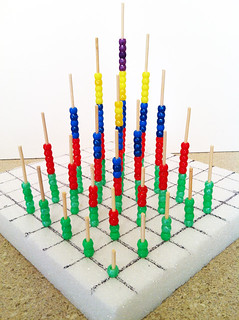
Malke writes: “When we started building this tower the questions started flooding in. I started wondering about a LOT of things…” Indeed! So will you wonder, if you build the tower.
2013 Sarah Dees
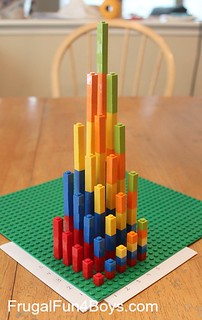
In her blog post, Sarah included detailed instructions and her thought about the design. She writes: “The finished graph lends itself to interesting observations if you look at it from different angles. I ordered the blocks from the Pick-a-Brick section on lego.com. We have invented several math activities with these bricks (more posts to come!), and it has been totally worth the cost.” Sarah’s activity was inspired by Malke’s beads.
2013 jmommymom at Highhill Homeschool
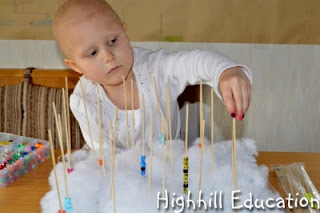
What a creative way to replace materials! The blog post explains: “We didn’t have a foam block, so we filed a cardboard box with cotton to serve as our base. Then we stuck in wooden skewers in a 5×5 grid pattern, and added beads to that corresponded with the multiplication tables.” This activity was inspired by Malke’s beads, as well.
2013 Andrew Staroszik and Roman Hegglin on Thingiverse
In 2013, several tower model appeared on Thingiverse, a 3D printing site. You can use these files to print your own towers.

Andrew’s tower was originally inspired by Michael Punzak’s wooden model we describe below.

Roman’s tower comes with captions in Roman numerals and Braille. It’s also made of thin tiles rather than cubes. These two features make for more formal or abstract remixes.
2010 Brenda Weiss
Brenda is a physicist and a creative parent. When her son Corbin set out to make a multiplication table with Cuisenaire rods, he built the first set of towers on his own. Brenda writes: “In ‘helping’ make it symmetric, I ended up knocking over most of what he had built. We built this together. Corbin was responsible for the multiple block levels, as I couldn’t balance more than two blocks.” It helps kids to know they are giving real help. Take a page out of Brenda’s book: be open about the areas where you need help.

2010 Colin Graham
Colin made a collection of 20 math adventures with LEGO, modeled with the free Digital Designer software, and invited colleagues to add more ideas. Here is the multiplication tower from his collection.

2007 Studio 1:1
The design studio from Gdansk, Poland made this giant tower and took several artistic photos of it.

2004 and up, Maria Droujkova’s Math Circles
Five Math Circle kids built these LEGO towers on a chessboard in 2010. The story was that each block was a creature (hence the smiley faces) that kept growing from row to row.
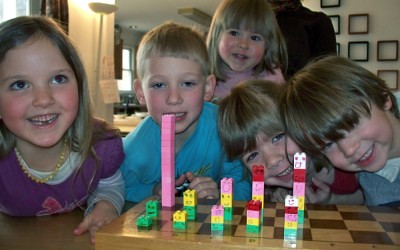
Later in 2010, the same Math Circle built a model with a cereal box and bamboo skewers. The picture shows the 3 by 4 array with pencils. The skewer in the lower right corner of the array sticks out by 12 units, that is, 3×4.
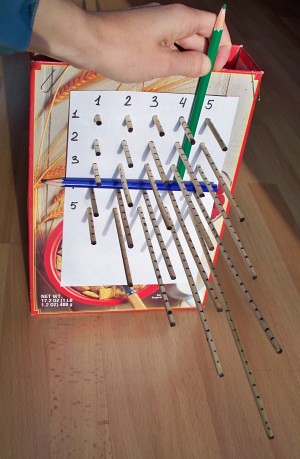
The above model was inspired by the Kinetic Structure BMW installation:
An earlier picture, from 2004, shows two kids from a Math Circle building with LEGO on a poster board.
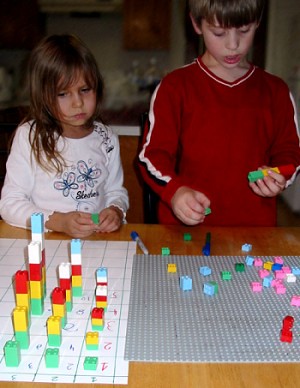
2001 and up, Dor Abrahamson and friends
In 2010, Dor wrote: “Multiplication Tower as an Object-to-think-with.” Well put! Check out Dor’s page about 3d multiplication, with more pictures, at his Embodied Design site at University of California, Berkeley. This six-foot structure made of wood was constructed by Michael Bryant, one of Dor’s graduate students.
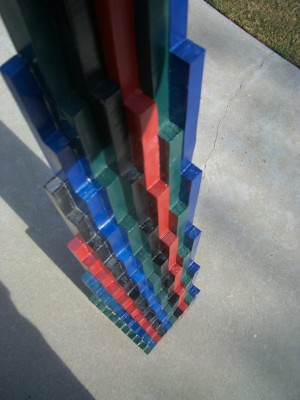

In 2005, when 3D printers were still rare, Paulo Blikstein printed this model at Uri Wilensky’s lab. Here is Dor playing with the Tower. Paulo now leads Transformative Learning Technology Lab at Stanford.
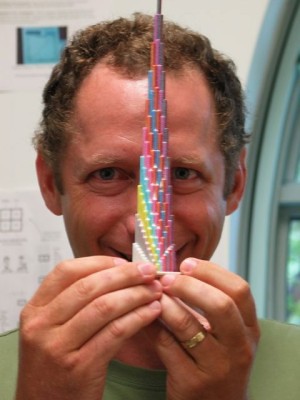
Here is a third grader building the multiplication tower from plastic blocks and play-dough in one of Dor’s experiments in 2001.

That was the year Dor designed the tower, first as a 3D output from a spreadsheet. Here is that historic document.

1988 and up, Michael Punzak, Michael Gleason, Douglas Shult, and Joshua Tenenbaum
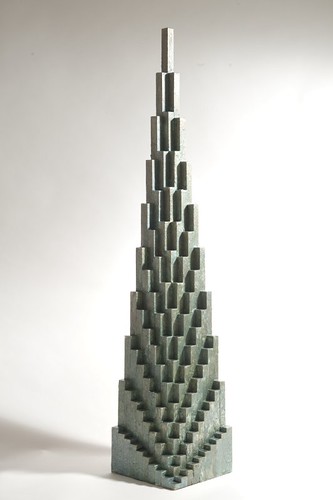
Michael writes in commentary to his page of lovely hands-on explorations into patterns: “I made my first model about 20 years ago. It was inspired by an article and photograph in The Mathematics Teacher (Shult, and Tenenbaum, 1988: A three-dimensional multiplication table inspires mathematical discovery). I found this first model, which is about 3 feet tall, a lot of fun to paint (about 10 coats of acrylic, to get a metallic look to it) but very heavy to schlep around. I commissioned a friendly carpenter, Michael Gleason of Newton, MA, to build a smaller (about 18 inches tall) model, which is much lighter. I also use a 5-by-5 multiplication table model built with LEGO blocks for volume and surface area challenges. It is surprising and a bit disappointing that so far my 4-6 graders (a STEAM) after school class in Needham, MA, have not made the necessary jump from the 5×5 model to the 10×10 model.”
1975 Don Cohen
In the oldest multiplication tower we found, the layers were cut out of wooden Dienes blocks by Don. He has kept it around for his students to build up the layers and to find more patterns. His camera wasn’t good at close shots, so the numbers here are written over the picture. Check out Don’s work on calculus by and for young people!

Happy tower building!
Related Posts
Posted in Grow
4 comments on “Multiplication Towers”
2 Pings/Trackbacks for "Multiplication Towers"
[…] Another modification is about tools and media. Our original activity might call for painting, but kids who don’t like to paint can use clay, or building blocks, or flower arrangements. We try to give specific hints for different media, for example that a symmetry activity requires a lot of folds, so you are better off with thin paper. But we want everyone to experiment on their own, like in this large crowd-sourced collection of multiplication towers. […]
[…] Take a multiplication table and build a column of cubes over each entry. For each column, use as many cubes as the product it sits upon. The result is a “multiplication sculpture” or “multiplication tower.” The picture shows a 15 by 15 multiplication sculpture built by Jane Kostick in 2008. For more examples, check out Maria Droujkova’s photo collection at moebius noodles. […]



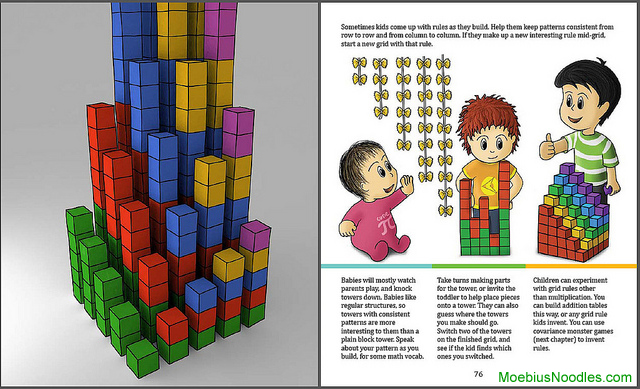






Those multiplication towers that are “life” size or taller have the “Wow” factor needed to hook those that might be “oh, hum” with the table top size. Love them, let’s make them taller and put some in playgrounds!
What’s in a color? How would (or did) Maria Montessori use color in constructing a multiplication tower? Where might I post a couple images?
You can email images to moby@moebiusnoodles.com so we post them in the next issue of Multiplication Towers. I was thinking of implementing this with Montessori beads. I think you’d have to hang them down from a fabric grid, so you can hook the beads to the fabric.
Will love to see this!